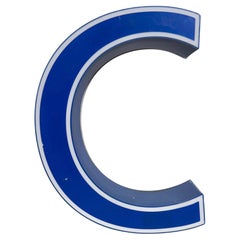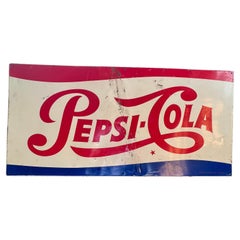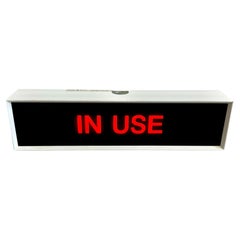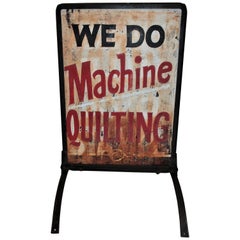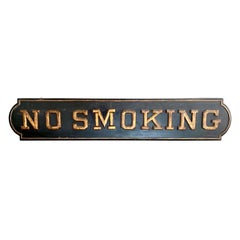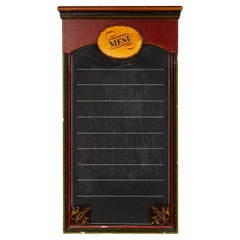Signs
1970s Italian Industrial Vintage Signs
Plastic
Mid-20th Century Italian Folk Art Signs
Metal, Enamel
1980s American Vintage Signs
Metal
20th Century American Rustic Signs
Metal
1930s American Vintage Signs
Wood
1920s Art Deco Vintage Signs
Wood
20th Century English Signs
Metal
1970s Italian Industrial Vintage Signs
Metal
1980s American Vintage Signs
Steel
1950s American Folk Art Vintage Signs
Composition, Metal
20th Century British Mid-Century Modern Signs
Aluminum
Early 1900s French Victorian Antique Signs
Zinc
1990s American Signs
Steel
Mid-20th Century English Mid-Century Modern Signs
Wood
1970s Italian Industrial Vintage Signs
Bakelite, Plexiglass
1970s English Mid-Century Modern Vintage Signs
Wood
Late 20th Century American Adirondack Signs
Wood, Paint
Early 20th Century British Signs
Brass
Early 20th Century Industrial Signs
Enamel, Steel
1970s Italian Industrial Vintage Signs
Metal
1950s British Folk Art Vintage Signs
Iron
20th Century English Signs
Metal
1920s American Vintage Signs
Metal
Mid-20th Century American Folk Art Signs
Wood, Paint
Mid-20th Century American Signs
Steel
Late 19th Century American Late Victorian Antique Signs
Iron
1950s American Mid-Century Modern Vintage Signs
Enamel
Mid-20th Century American Country Signs
Wood, Paint
1960s French Art Deco Vintage Signs
Plaster
Mid-19th Century American Primitive Antique Signs
Iron
1980s American Vintage Signs
Plastic, Paper, Felt, Wood, Paint
1950s French Mid-Century Modern Vintage Signs
Iron, Zinc
1970s German Industrial Vintage Signs
Metal
1950s American Folk Art Vintage Signs
Iron
1940s American Adirondack Vintage Signs
Hardwood, Paint
Mid-20th Century American Industrial Signs
Steel
Late 19th Century Antique Signs
Metal
1950s American Folk Art Vintage Signs
Sheet Metal
1930s American Art Deco Vintage Signs
Metal
1970s Italian Industrial Vintage Signs
Iron
19th Century American Folk Art Antique Signs
Wood
Early 20th Century American Folk Art Signs
Pine, Paint
1940s American Folk Art Vintage Signs
Wood
Mid-20th Century American Folk Art Signs
Metal, Iron
Early 20th Century American Signs
Steel
1990s American Signs
Steel
1940s American Art Deco Vintage Signs
Chrome, Steel, Aluminum
Late 19th Century American Folk Art Antique Signs
Wood
1950s Vintage Signs
Reclaimed Wood
19th Century French Folk Art Antique Signs
Iron
Late 20th Century British Post-Modern Signs
Natural Fiber, Paper
1920s English Industrial Vintage Signs
Milk Glass, Oak
1950s American Folk Art Vintage Signs
Wood
Mid-20th Century American Folk Art Signs
Pine
1980s Italian Industrial Vintage Signs
Metal
Early 1900s American Folk Art Antique Signs
Tin
1980s Italian Industrial Vintage Signs
Iron
19th Century American Antique Signs
Metal
1960s French Art Deco Vintage Signs
Plaster
1990s Italian Mid-Century Modern Signs
Metal
Antique, New and Vintage Signs
Vintage and antique signs are popular collector’s items loved not only for the charm and pops of color they add to a space but also for the unique story each one has to tell. An interesting sign can help set the mood for a room and spark dozens of lively conversations.
Before and during the 18th century, many European peasants and colonists in the Americas couldn’t read, so shopkeepers, in an effort to promote their goods and services, hung trade signs with limited amounts of text.
Indeed, symbols and representational physical objects comprised early-day advertising efforts. In lieu of painted words on a wooden board, trade signs made use of handmade three-dimensional symbols to indicate the function of the shop. The iconic red, white and blue pole could be found outside barbershops, while a figural trade sign mounted to an apothecary’s storefront might be a mortar and pestle sculpted from bronze in order to indicate to passers-by that inside there were apothecary cabinets full of remedies for common ailments and a druggist to carefully dispense them.
As literacy rates improved, signs evolved into rectangular, round or square shapes that featured text. Short and sweet, early iterations were characterized by a mere few words, such as “tavern,” “boarding room” or “apothecary.”
During the 19th century, proprietors endeavored to render their signs more appealing. This meant the introduction of more color, font types and other pictorial representations. After the Civil War ended, logos, branding and advertising became increasingly more important, and the design of signage evolved. Trade signs were still in use during the 20th century, and you will likely find hand-painted tin eyeglasses for an optometrist’s office or an oversize bowling pin that likely had a home in the front window of a bowling alley.
Today, collectors and art aficionados alike collect and display antique and vintage signs. Old signs hearken back to a long-gone era, infusing any interior with warmth and nostalgia.
A vintage sign can help anchor a room — think of decorating with signs as you would arranging any kind of wall art. A large-scale sign in particular can prove a distinguishing feature in a living room or dining room, a focal point so prominent that it might lessen the burden of introducing any additional decorative elements to this particular space. Smaller signs work wonders too — pepper sparsely decorated corners with small colorful signs or add a humorous or graphic element to your gallery-style hang with a small text-based sign or two.
On 1stDibs, find metal, wood and glass antique and vintage signs that span a number of styles, including mid-century modern, industrial and folk art.
